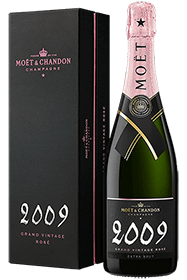Moët & Chandon, a historical House producing rosé champagnes
Moët & Chandon is regarded throughout the world as being one of the most famous and influential Champagne Houses. Since its creation in the 18th century, innovation has been at the very heart of this champagne house. The house’s values have enabled it to adapt to consumer trends over the years and to gain the worldwide reputation that is enjoys today. Although rosé champagnes have been relished all around the world for close to ten years, the oldest Moët & Chandon rosé champagne harks back to 1878, 135 years after the foundation of the house. Records show that Napoleon Bonaparte acquired "Rozé" champagne in 1794.
Wines reflecting the quality of the terroirs and a unique know-how
Thanks to the plots planted predominantly on limestone soils and to a wealth of know-how perpetuated for several centuries, Moët & Chandon produces high quality champagnes.
Moët & Chandon reigns over an array of exceptional terroirs
1150 hectares are spread across the 5 areas of the appellation in France: the Montagne de Reims, the Côte des Blancs, the Marne Valley, the Côte des Bar and the Côte de Sézanne. Moreover, 75% of their production area is classified as Crus, Grands Crus and Premiers Crus. The house's diversity enables it to select the finest grapes and to produce 4 classic cuvées, but also, following exceptional years, to produce their remarkable Grand Vintage rosé champagne. The house, fully aware of the importance of preserving the balance of its soils, applies sustainable viticultural and integrated agricultural practices which have protected the surrounding environment for several years.
A rich signature blend
Moët & Chandon is located in Épernay, in the Marne Valley. Its mythical cellars, stretching over 28 kilometres, are dedicated to the maturation of champagne.
The blend of each cuvée is what truly makes them stand out and gives them a distinctive style. However, Moët & Chandon uses mostly red grapes for the production of its champagnes. Pinot Noir is the most planted grape variety and provides the wine with a pleasant structure and intensity. Pinot Meunier, which makes up 40% of the blend, adds roundness and Chardonnay lends a fresh expression. Among all rosé champagnes, Moët & Chandon rosés are renowned for their delicate and complex expression.
Three rosé champagnes are available
Moët & Chandon is also known for producing different types of rosés. Three very unique styles stand out.
The Brut Impérial Rosé
This champagne boasts the same characteristics as the house’s classic cuvées and the proportion of Pinot Noir and Pinot Meunier is more important than in the Brut Impérial champagne. It is chock-full of fruity aromas and exudes notes of strawberries, raspberries and redcurrants and a lively expression punctuated by minty aromas. This champagne possesses a delicious and fresh expression.
Ice Impérial Rosé
This cuvée is a style of champagne, elaborated by Moët & Chandon, specially designed to be relished with ice cubes. It is in line with the house’s other cuvées and mostly comprises Pinot Noir. However, up to 30% reserve wines are used in the blend, giving it a pleasant richness. Ice Impérial Rosé is different from the other champagnes, it is a demi-sec champagne and thus, its sugar levels reach 45 grams per litre. It is a gourmet champagne that goes beyond the rules of wine tasting. Moët & Chandon, which is constantly seeking innovation and creativity, is constantly seeking to renew its consumption patterns. This sparkling wine is destined to elevate an array of joyous and unforgettable celebrations.
The Grand Vintage Rosé
Unforgettable years deserve special attention, which is why the House has created vintage champagnes. Their blends do not follow the same criteria as their other sparkling wines. These vintages are aged for 7 years in the cellar and another 6 months after disgorging. The major difference with other rosé champagnes is that their sugar levels are much lower, only 5 grams per litre, making them Extra Brut. Grand Vintage Rosé bottlings are rare and exceptional, they stand out for their organoleptic characteristics, notably their ageing potential and their complexity which justify their position among the finest gastronomic wines. Thanks to the plurality of their profiles, these Moët & Chandon champagnes will suit an array of events and celebrations.
Exceptional rosé champagnes
Each and every Champagne House stores an array of hidden treasures in their dark and peaceful cellars. Since the creation of Moët & Chandon, 74 white and rosé cuvées have been declared as vintage. The emblematic Grand Vintage rosé champagnes are the 1998, 1980, 1976, 1961, 1955 and 1949 vintages.
Unique and memorable food and wine pairings
Forget the traditional glass of champagne to serve as an aperitif and with a dessert... Moët & Chandon rosé champagnes are versatile and can be paired throughout a meal. To truly make your mouth water, here are some menu ideas that will complement Moët & Chandon champagnes.
- As a starter, fish, shellfish and crustaceans will go wonderfully well with the Brut Impérial Rosé. You can opt for salmon carpaccio which will harmoniously complement the texture of this champagne.
- When serving the main course, you can pop open a bottle of Grand Vintage Rosé 2013 and pair it with, for example, red mullet à la plancha or stewed scorpion fish. Dishes served with a red wine sauce will pair beautifully with this sparkling wine. It is crucial to preserve the well-balanced intensity of the whole so that neither the food, nor the champagne overshadow the other.
- With the dessert, Ice Impérial rosé is a must with red fruits, exotic fruits like mango or watermelon with spicy notes. The alliance between pleasant aromas and a suave texture will lead to an utterly exquisite food and wine pairing experience!
An array of food and wine pairings will complement rosé champagnes, even the boldest pairings. You just have to respect certain criteria but feel free to let your imagination run wild.




